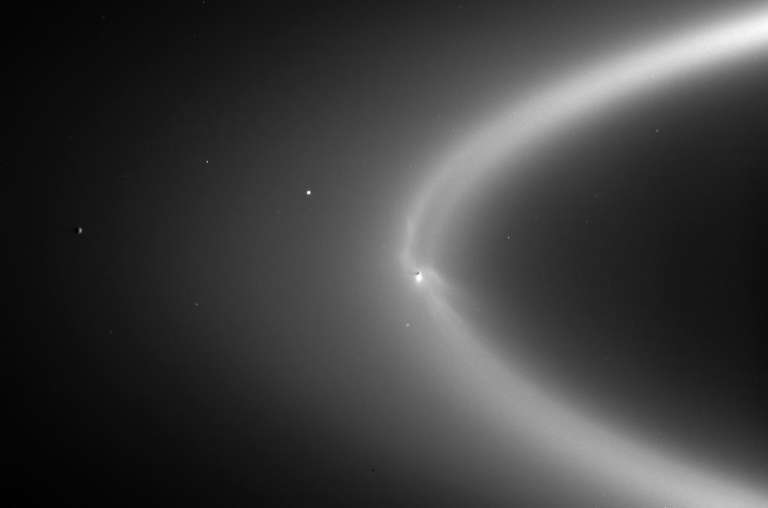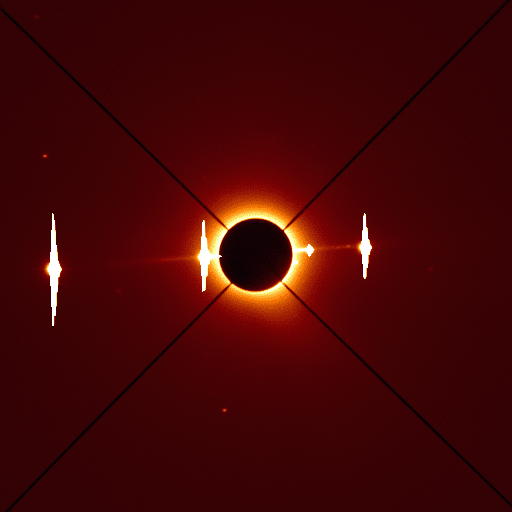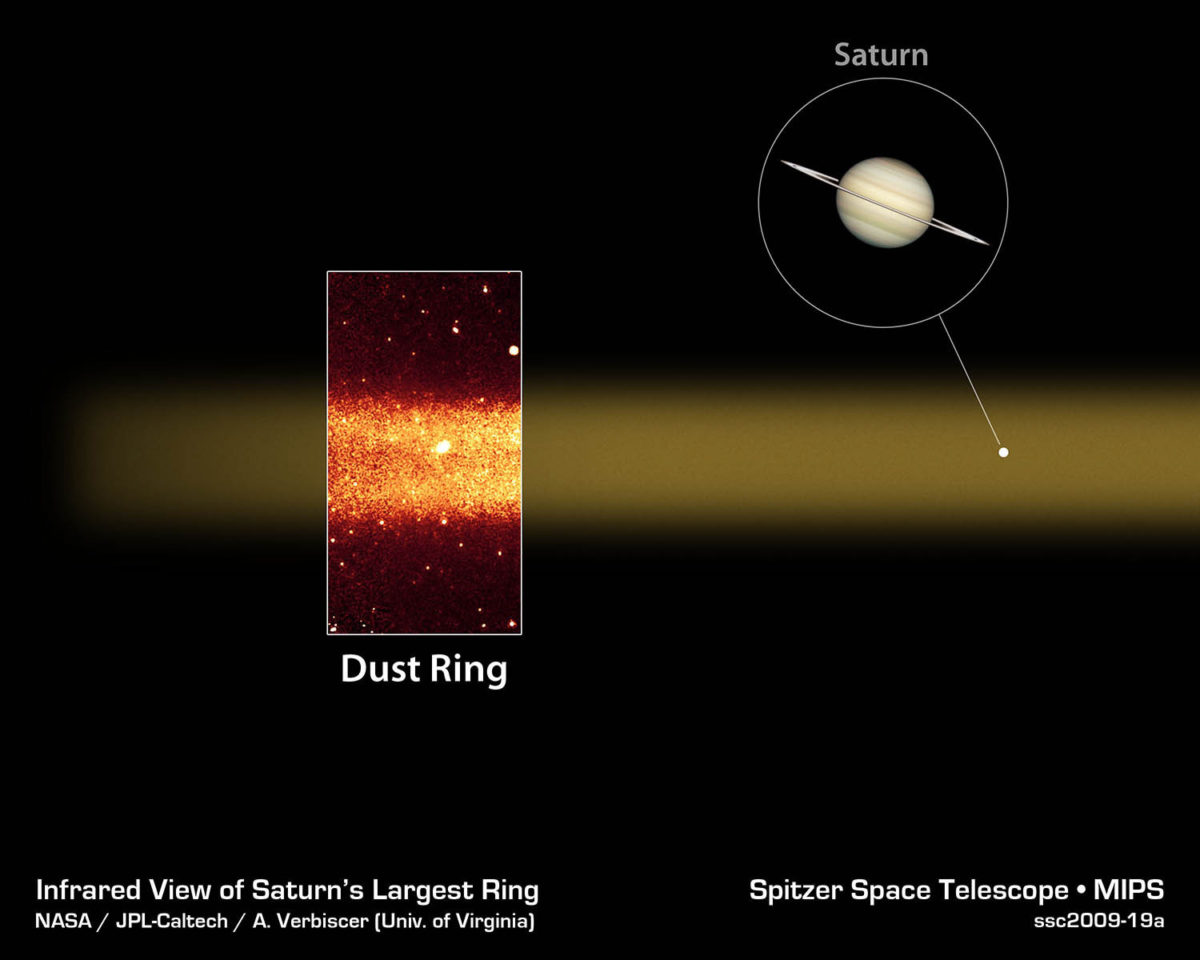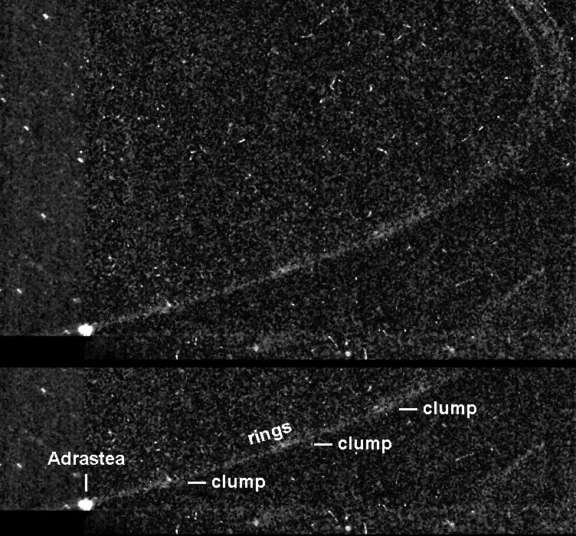Emily Lakdawalla • Oct 14, 2009
The Phoebe ring
Sorry I'm late to this news, but as usual I'll try to compensate by being thorough! Last week, planetary astronomers Anne Verbiscer, Michael Skrutskie, and Doug Hamilton published a paper in Nature succinctly titled "Saturn's Largest Ring." In the paper, they announce the discovery, using the Spitzer infrared space telescope, of a gargantuan, previously unseen ring around Saturn, encompassing the orbit of Phoebe.
First, let's start with some background on the scale of Saturn's known rings. (Click here to skip the background and go straight to the Spitzer results.) You can measure the extent of the rings in kilometers, but astronomers and Cassini mission people both seem to find "Saturn radii" to be a handier unit that helps them have a better intuitive feel for the scale of things. One Saturn radius, abbreviated as R-subscript-s but usually written just as Rs to make things easier, is 60,330 kilometers. Beginning at Saturn's center, one radius gets you to Saturn's cloud tops. The main ring system, the part that's almost perfectly flat and aligned with Saturn's equator, includes the D, C, B, A, and F rings and is just a bit more than twice Saturn's diameter.

Moving out from the main ring system, you get to the first ring that's extended vertically above and below the ring plane, and that's the G ring. In 2008, Cassini's imaging team discovered a tiny moon, now named Aegaeon, that orbits within it and is most likely the source of the material that makes up the G ring. Whenever rocks of any size smack into Aegaeon -- and there's plenty of such bodies wandering around the Saturn system, so such impacts are relatively frequent -- ejecta sprays off from the collision. Aegaeon is so tiny that its gravity is incredibly weak; the ejecta doesn't crash down to land back on the moon but instead winds up orbiting Saturn. The ejecta's orbit is pretty similar but not identical to Aegaeon's orbit, so you wind up with a ring of material composed of millions of tiny particles, each on its own orbit. The G ring extends to about 2.9 Rs.

Next you get to the E ring. Unlike the G ring, which is dusty, and indeed unlike most rings observed anywhere in the solar system, the E ring is blue in color and composed predominantly of relatively uniformly sized particles of ice. It is enormous, going from about 3 Rs maybe all the way to the orbit of Rhea at almost 9 Rs. It varies in density, and is densest at the orbit of Enceladus, at 4 Rs. These characteristics of the E ring made planetary astronomers strongly suspect that some kind of internal geologic activity on Enceladus was supplying the E ring, and of course Cassini proved that surmise to be true.

And that's it; that's the extent of the ring system known before this discovery. It went out to about 9 Rs. Here's a photo of the ring system from Earth, taken during the last Saturn equinox and ring plane crossing in 1995. During the equinox, we see the rings edge-on, which makes it easier to spot faint rings using a telescope; their entire radial thickness is collapsed into one line across the sky, so you're effectively seeing a much thicker pile of dust.

E ring: 9 Rs. So when I say that the new ring discovered by Anne Verbiscer and her coworkers extends from 128 to 207 Rs, you should really be pretty amazed.
Most of Saturn's moons are part and parcel of the main ring system -- the E ring includes the orbits of Mimas, Enceladus, Tethys, Dione, and possibly Rhea. In terms of their distance from Saturn, you can think of them as the "single-digit-Rs" family. These moons all look pretty similar.
Beyond Rhea, the moons are suddenly spaced much farther apart, and have very different appearances. You have cloudy Titan and dark Hyperion at about 20 and about 24 Rs. Next comes two-faced Iapetus, which -- unlike all the moons I've listed so far -- has a notably inclined orbit and is all the way out at almost 60 Rs. This is the double-digit-Rs family.
Beyond Iapetus, there's another big gap and then you get to another totally different family. These moons tend to be very, very small, only a handful of kilometers in diameter, and they have inclined, eccentric orbits that are anywhere from roughly 200 to 400 Rs -- the triple-digit-Rs family. Their odd orbits have made astronomers suspect that they didn't form with Saturn but instead are captured wandering bodies -- Centaurs or even Kuiper belt objects. Standing out among these because of its size is Phoebe, which is 215 kilometers across, the only one that has ever been seen up close by a spacecraft.
The Cassini mission made special plans to fly past Phoebe during its cruise to Saturn; the encounter was on June 11, 2004. It was so far from Saturn that after sailing past Phoebe it took Cassini 19 more days to get to its rendezvous with Saturn for its orbit insertion!!

All it takes is one glance at Phoebe to know that a lot of it has been blasted away due to numerous impacts with other, smaller bodies. So it is no stretch at all to imagine that, much as there is material in Aegaeon's orbit making the G ring, there should be material in Phoebe's orbit making a ring. Verbiscer and her coauthors predicted that there might be such a ring. But Phoebe's orbit is so incredibly large that this "ring" would be almost unimaginably sparse. It's so sparse that Cassini's instruments, wonderful though they are, have no hope of seeing the ring as any kind of object against black space.
But the Spitzer Space Telescope is a different story. In February of this year, Verbiscer and her colleagues pointed Spitzer's Multiband Imaging Photometer (MIPS) to image the region in several disconnected locations along Saturn's ecliptic plane all the way from Iapetus' orbit to 400 Rs at wavelengths of 24 and 70 microns.
What they found was "a diffuse double-peaked band of light coincident with Saturn's ecliptic plane." The band of light was found in an observation that spanned the region from 128 to 180 Rs. It was also seen in smaller snapshots that were centered on the outer moons Kiviuq (153 Rs) and Tarvos (180 Rs). Its presence was equivocal in an observation centered on Phoebe at 220 Rs. And there was no evidence for it in an observation centered at 400 Rs. Combining all these observations gives positive identification of the presence of the ring from 128 to 207 Rs, though its extent could be larger. The diagram below shows you the Spitzer observation that covers the region from 128 to 180 Rs.

The vertical thickness of the ring was observed to be about 40 Rs, and it has a curious double-peak in intensity -- that is, it's not thickest along Saturn's equator, but instead looks like two rings floating above and below Saturn's equator. Why does it look like that? This is actually one of the observations that ties it to Phoebe.
Phoebe has an elliptical orbit whose plane is inclined 5 degrees to Saturn's ecliptic (not equatorial!) plane. Bodies that are ejected from Phoebe but remain in Phoebe's orbit will share this 5-degree inclination. That means that they rise above and below the ring plane. Doing a little math using Phoebe's average orbital distance (215 Rs) and its orbital eccentricity (0.16) and its inclination (5 degrees) produces a prediction that the ring should be about 41 Rs thick, remarkably similar to the observation. Because the orbits precess with time, at different rates depending upon their average distance from Saturn, the orbiting ring particles spread to cover all possible spaces in which Phoebe orbits. This movie may help you understand the location and extent of the ring. Visit my Facebook page for the same in HD resolution.
So far, it's a cool result but it's sort of like stamp collecting -- we discovered a new X and described it, done. Where the paper gets really interesting is when the authors explore what happens to the particles in Phoebe's ring over time, something that you can model by writing down a few equations that describe the orbit of a particle, include Saturn, Phoebe, Iapetus, and Titan, include the masses, densities, and albedos of the particles, and the effects of incident sunlight.
What happens to particles depends upon their size. The biggest chunks, several centimeters in size or larger, don't really migrate anywhere, sticking around near Phoebe's orbit until they smack into something -- each other or Phoebe. The model simulation suggests that it would take more than the age of the solar system for half of the particles to be removed from the system by re-collision with Phoebe, so most of the biggest chunks are still out there somewhere in Phoebe's orbital space.
What about smaller particles? The article says "re-radiation of absorbed sunlight exerts an asymmetric force on dust grains, causing them to spiral in towards Saturn with a characteristic timescale of 1.5 x 105rg where rgis the particle radius in micrometers. This force brings all centimeter-sized and smaller material to Iapetus and Titan unless mutual particle collisions occur first....Most material from 10 micrometers to centimeters in size ultimately hits Iapetus, with smaller percentages striking Hyperion and Titan." This would be a slow process that has operated continuously since whenever Phoebe was captured into Saturn's orbit. There might have been bursts of material delivered to Iapetus associated with some of the bigger impacts that have left such large scars on Phoebe, but they would have been blips above a steady background.

Anyone who knows the first thing about Iapetus should be saying "Aha!" at this point. Iapetus, is, of course, known for being the yin-yang moon, whose leading hemisphere is dark and whose trailing hemisphere is bright. Cassini observations of Iapetus have proven that the dark material is almost certainly exogenous (coming from outside) rather than endogenous (coming from internal geologic activity). The small number of fresh, rayed craters on Iapetus shows that the darkening process is continuing today. The fact that the dark stuff only shows up on the leading hemisphere -- the side of Iapetus that faces forward in its orbit -- suggests that it's "sweeping up" the dark material, plowing into it as it moves in its stately path around Saturn. The side of Iapetus that faces backward along its orbit is in the lee of Iapetus' motion through the cloud of particles and doesn't sweep up the material.
It's long been suggested that Phoebe could be the source of this dark material. Verbiscer et al. go on to do some calculations that suggest that Phoebe material accumulates on Iapetus at a rate of about 40 micrometers per million years; over the age of the solar system that gives you 20 centimeters of material deposited on Iapetus. But because there were probably once a lot more distant kilometer-scale moons of Saturn that eventually crashed into Phoebe, the production rate of Phoebe ring material and therefore the Iapetus accumulation rate in the past was very likely higher, "leading to...a cumulative thickness of material on Iapetus that is probably measured in metres."
It's all a pretty neat picture. It doesn't even require Phoebe to have any kind of unusual geologic activity or unusually large past impacts -- all it needs to be is a big body sitting in its distant orbit, and other bodies in the Saturn system will crash in to it and create this supply of material that eventually impacts Iapetus. One question I haven't answered yet though is how come Phoebe has a ring if such structures haven't been seen around other moons? For instance, someone asked me, why isn't there a dust ring around the orbit of our Moon?
In a way, the way we are finding fainter and fainter rings is parallel to the way we're finding smaller and smaller moons. I'm pretty certain that there are a few motes more dust along our Moon's orbit than there is outside our Moon's orbit, but the Moon is so large, with such strong gravity, that nearly everything that is ejected from any impact on the Moon almost immediately returns to the lunar surface; no one will ever find a "ring" in the Moon's orbit.

Elsewhere in the solar system, as you look to smaller and smaller moons, you will see more and more dust associated with that moon's orbit. In the Saturn system, the Cassini mission is careful as the spacecraft crosses the orbits of all the medium-sized moons like Tethys, Dione, and Rhea, pointing the high-gain antenna forward along its path so that the antenna acts like an umbrella, shielding the more sensitive instruments from collisions with little dust particles.
Look at the even smaller moons Thebe and Amalthea at Jupiter, and there are definite "gossamer rings" associated with their orbits. Interestingly, Verbiscer et al. point out in their paper that Thebe and Amalthea are "far more prolific sources of debris" than Phoebe because their close location to Jupiter means that collisions are more energetic, but because the debris from collisions re-impacts Thebe and Amalthea very quickly, the optical depth of their associated rings is actually very similar to the optical depth of the Phoebe ring, even though the Phoebe ring is far larger; which means that the Phoebe ring contains thousands of times more material than the Thebe and Amalthea gossamer rings do.
The article concludes: "Although [its] exotic properties as well as its sheer size make the Phoebe ring unique among known planetary rings, similar structures should also adorn the other gas giant planets." In other words, there's a lot more out there to be discovered!

Support our core enterprises
Your support powers our mission to explore worlds, find life, and defend Earth. You make all the difference when you make a gift. Give today!
Donate

 Explore Worlds
Explore Worlds Find Life
Find Life Defend Earth
Defend Earth

